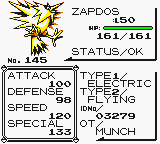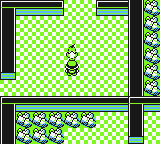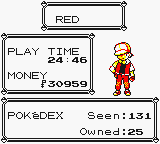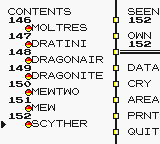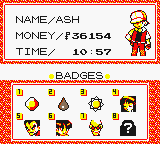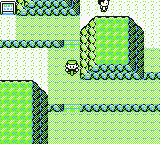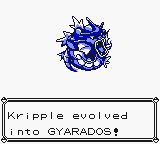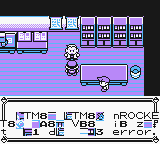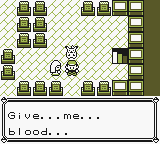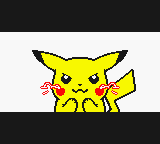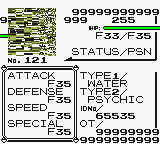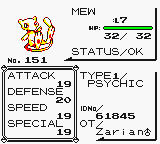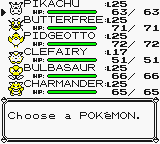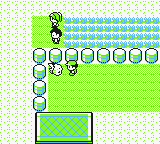Pokemon Yellow: Special Pikachu EditionTo say life can be overwhelming on mere mortals is a considerable understatement. Indeed, life can be flat out cruel, in the eyes of humans, as the bad has to be taken with the good. What constitutes as “bad” or “good” depends entirely on a human's concept of what is owed to them/their desires, and what they really may get. It is rather interesting how some humans copes with the immense differences between their desires and what becomes reality; some may resort to “being the man who arranges the blocks” as Tetris personifies, and some relies on escapism.
Escapism is the core of all human creativity and innovation; it is only through closing the doors to the outside world can another world be opened up to the mind's eye. It is when a human enters this world that great ideas are spawned, and these ideas often returns with the human when they re-enters the “real world.” Escapism is all forms of expression, whether it is music, art, literature and even video games. A good example of fantasies being made reality is Pokémon.
Pokémon have been around for over 15 years, and still going fairly strong. The basic premise is that these creatures/companions inhabit the world with humans, and humans built their entire lives around these Pokémon, whether it be for battling, breeding or simple company. The Pokémon franchise covers all forms of medias, but ultimately it began as two role playing games: Pokémon Red, and Pokémon Green (Blue outside of Japan). Needless to say these were quite successful, and the success prompted numerous forms of expansion, including the third game in the first generation: Pokémon Yellow. Yet how does this game differ from its predecessors, and is it worth the time of day to play?
Pokémon Yellow, like its relatives, is essentially a game where the player is to, with a starter Pokémon, go on an adventure building a team, and battling their way to the top while filling out their Pokédex (an encyclopedia that records all Pokémon seen and caught). It do have some differences to its other first generation counterparts, which will affect the game play significantly, and these will be brought up later. First, however, are the game's general stats and information, for someone unfamiliar with the first two games.
Visually, the game is quite competent for a hand-held of it's era. It reuses a significant number of sprites from blue and red, as it is taking place in the same region with similar characters and the same Pokémon. There are minor configurations here and there, particular with saturation: some characters would appear to have a yellow saturated appearance now. As well, some extra sprites were added, like Chanseys in Pokémon Centers. One beneficial addition was how different areas got a different prevalent tone to it (for instance, Cerulean City has a significant blue monochromatic style) which helps vary up the environments. The soundtrack is largely memorable, but how appealing it is depends entirely on the player. Music has always been one of the major subjective natures about video games, but for an 8 bit game is quite well done, on a technical level. The only real problem with the music is certain events are tied with certain soundtracks in a manner that is annoying. The most prevalent example is that while on the bicycle, only its theme can be heard. The problem there is if someone dislikes it, they have to resort to either turning the sound off, putting up with a potentially annoying tune, or walk. The other sound effects, like moves in battle, is solid as well, but not a lot to say except they may also be annoying after several hours of straight playing, but that depends entirely on the player's opinion.
The game play is almost impossible to describe in brevity, but can essentially be split into the over world/travelling aspects, and the actual combative nature. These two are tied together considerable, but there’s an obvious distinction.
The first of these two forms of game play is by far what is the most common, and it is a mixed bag. It follows a style that would be familiar to Final fantasy fans: a birds eye view from a certain angle, that the player travels from place to place and prepares for the combat. It is pure and simple classic role playing; certain areas are cut off until later in the game, growing progressively harder over time, and with the player's decisions out of combat having a significant impact on how they will fare later. Indeed, this is the time when the player has to decide how to build their team, buy and sell supplies, and figure out how they will proceed. The actual movement is largely linear, requiring the player to complete the game in a general set frame, and to a degree the teams, yet the player has almost total freedom to return back to previous places they been to. Almost. Certain points in the game is completely impossible to return to parts the player been to previously until they acquire a certain item (usually an HM, a Hidden Machine). Nonetheless there is nothing stopping the player from hunting down rare and powerful Pokémon before they fights the Elite Four.
To store said Pokémon, there is a Box system where all of a player's Pokémon can be kept while they carry around their main combat team. Each box would store 20 Pokémon maximum, and if a box is full the player would have to switch to another. They can be switched between from any PC (except the one at home), and is essential to building a team and filling out the Pokedex. It is the first Pokémon storage system, and is understandably clunky to use, as it is a text based system. It is largely functional, but the main frustration is trying to find a Pokémon that is stored in the PC when several of these 20 Pokémon boxes are filled, so time to organize is absolutely essential.
There is also a box to store items, aka the player's PC. This is essentially to hold the items that the player is incapable of carrying around with them all the time, mainly unused TMs (Technical Machine) and HMs that the player wishes to save for later. This system is essentially one long list of items, and can take a long time to sort through, especially with HM/TM's biggest flaw: a lack of name. The item is simply labelled with Tm or HM and a number, but what the item actually does is unknown until the player actually uses the item. For HM moves, it is rather simple as there are only five, but with up to 50 TM's, the player needs to either have a list of all the TM's and their functionality, or manually sort through every single one. The item list also needs to be manually organized, but is quite simple to do so with the aid of the Select button. The player's inventory is almost as important as the team, as items to tend to Pokémon out in the field, like Potions or Antidotes, items to catch Pokémon, and general handy items like the Bicycle and Map are stored here. Having a healing item on hand could be the difference between victory and defeat. Overall, asides from the “clunky” nature of the Inventory and item/Pokémon storage, it is suitable; rudimentary, but adequate.
Combat works much like any other turn based role playing game: The player has to, with their team, eliminate the opposing trainer’s team, or defeat/capture wild Pokémon. The system basically relies on the player sending out Pokémon with a specific move-set and their stats. It is a standard system otherwise, and it is a strong system. There is definite elements of strategy as fair as which Pokémon to use, as all of them got various advantages/disadvantages, and a real risk vs reward system, as the tougher opponents the player goes against, the more experience (and possibly money if against a trainer) will be earned. As well, there is a definite advantage to actually working hard to raise a Pokémon rather than catch one of equal level, as its stats will be higher, and the player got much more control over which moves it may know. Combat isn't perfect however, in part due to the lack of ability to re-challenge trainers that the player has defeated before, with the exception of the Elite Four. This reduces replay value as sometimes someone would like to replay the gyms and other trainers, but keep their Pokedex and stronger Pokémon asides for later should they desire rather than lose it all (with the only way to preserve them is trade them to another cartridge and return, but that is not always possible).
Now, typically in a Pokémon game, the player would start with a grass, water, or fire Pokémon, but not in this particular version. The big thing that makes the game stand out is that the player's starter Pokémon is a Pikachu, mirroring the anime. Indeed, asides from adding a loose storyline based off of the anime series, this adds some interesting tactical considerations. For instance, how the player has to build their team is completely different now, especially as the three normal starters are available at varying parts of the game. Furthermore, your rival's team is different this time around, which can easily make the game a lot harder. Throw in the fact the player's first gym is one that is strong against Pikachu...it adds a few new elements to game play.
The storyline, as stated before, is only loosely based around the anime, but the player will pick up subtle references that is indigenous to the TV series. Not everything is the same, obviously, and a better representation of the Pokémon series could be found in a hack also on Vizzed. Nonetheless, there is still more to the story than the Red/Blue predecessors, but it is flat on the whole. Overall, it gets a pass but is a far cry from an amazing story.
The game is far from perfect, however. Asides from aforementioned issues of varying degrees, there are some flaws that could make or break this game for someone trying to play through, especially a total completion run. Many of these flaws would later be fixed in the second and third generations, but they're still here nonetheless.
Probably one of the biggest flaws would be repetition in training and travelling, and any veteran will know exactly what is meant by that. In order to truly be prepared for the challenges up ahead without losing frequently, the player has to know what is coming, and prepare accordingly. However, should the player discover they are lacking a certain Pokémon or move-set required to beat a certain spot (like say a gym) and it is unavailable through, they either got to train their team to prowess levels, or catch the required Pokémon and raise it from scratch. This brings up an interesting issue as well which can add repetition to travelling: wild Pokémon frequency. The general idea is after going through certain areas at a certain pace, Pokémon would be encountered randomly. However, there are spots that have an irrationally high frequency rate that could drive the player insane, with the most notable example being Zubat in caves. This makes moving through without battling exceptionally frustrating, and it is almost necessary to skip a lot of these the first time through any cave system as it could exhaust PP points, unless the player has either a large team or a strong one. Pikachu's electric attacks helps with Zubat, but it still does not make things go a lot faster. While this speeds up training, it is still extremely repetitive and makes certain parts of the game a drag to try and pick up. As well, though some spots have a plethora of wild Pokémon, with one coming up every few steps, there are areas it could be infuriating to find a wild Pokémon, especially one that gives any major experience points for making it faint. In short, training and navigation could prove very tedious as spots depending what the player's objectives are at that given moment.
As well, it is technically impossible to achieve all 151 Pokémon in Vizzed without using one of the home brew versions. The reason is that all three first generation games requires trading with other players to get some of the Pokémon from other games, and that is currently impossible through emulation, unless a multiplayer system could be implemented. Even with an actual game boy, the player would need to either have a very generous Pokémon Fan of a friend, or own two Game Boys, have a cable to hook them up, and own another game compatible with Yellow. As well, the player will be forced to have at least 2 playthroughs if a second generation game is the only means to trade, as certain Pokémon are unavailable through a game such as Silver.
In conclusion, there isn't much, if anything, that hasn't already been said about Pokémon Yellow. It is an extremely high selling game, and is critically acclaimed by a large number of reviewers. Despite its flaws, it is ultimately a well built game, and is recommended alongside Pokémon Red or Blue, to add a slightly different approach to game play. For one of the first games in the series, it has a lot of potential, and that was shown over the series' subsequent game ironing out many of the flaws and finding ways to improve the game. It is ultimately competent in most aspects, and what few glitches there are is actually encouraged in order to get the 151st Pokémon, and a few special miscellaneous ones. However, Pokémon Yellow will always be there as a solid role play game, or maybe just a pocket full of memories. If the player wishes to have a game with a similar combat style to the traditional turn based system where one has to build a team, and don't mind the storyline, then this is a feasible option. Should the player desire an exceptionally deep or complicated story, especially for a Game Boy game, or is unwilling to spend hours upon hours playing, then look away. Fans of the Pokémon series should also look back at this gem, and if they never already play it for fun, or even just to see how the series has developed. As with many games like this, the player has to decide whether to throw that Poke ball, or let Pikachu go in the wild, but it will take time to make said decision.
Graphics
10 Sound
8 Addictive
7 Depth
9 Story
2 Difficulty
4


 User Notice
User Notice 
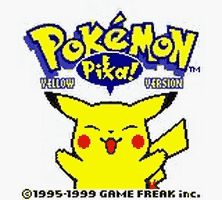
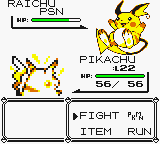
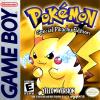

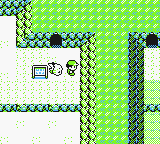


![Pokemon Yellow - www.vizzed.com Pokemon Yellow Part 2 [Piggy Time] - User video](https://i.ytimg.com/vi/Vs-Gppy6QKc/mqdefault.jpg)

![Pokemon Yellow - www.vizzed.com Pokemon Yellow Part 1 [Pika Pikachu] - User video](https://i.ytimg.com/vi/KWVPesDIotQ/mqdefault.jpg)





![Pokemon Yellow - www.vizzed.com Pokemon Yellow Part 4 [That was Onix-pected] - User video](https://i.ytimg.com/vi/Q3wkoZuzIlw/mqdefault.jpg)


![Pokemon Yellow - www.vizzed.com Pokemon Yellow Part 3 [Training...] - User video](https://i.ytimg.com/vi/wkcyKTP3h9k/mqdefault.jpg)





































